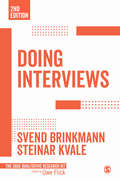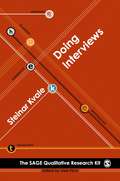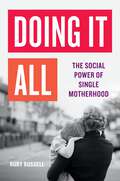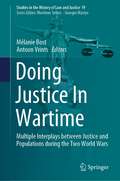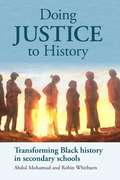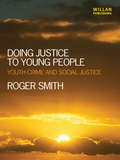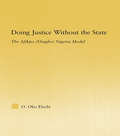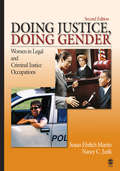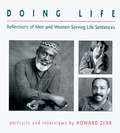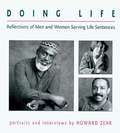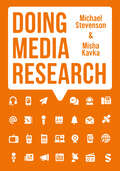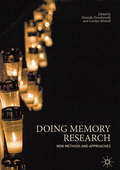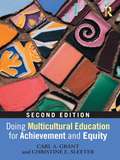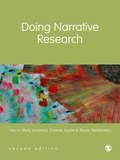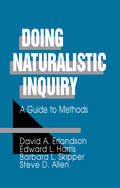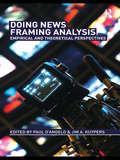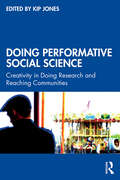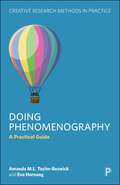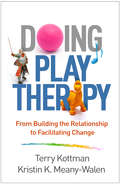- Table View
- List View
Doing Interview-Based Qualitative Research
by Jeanne Marecek Eva Magnusson Magnusson, Eva and Marecek, JeanneFor many students, the experience of learning about and using qualitative methods can be bewildering. This book is an accessible step-by-step guide to conducting interview-based qualitative research projects. The authors discuss the 'hows' and 'whys' of qualitative research, showing readers the practices as well as the principles behind them. The book first describes how to formulate research questions suited to qualitative inquiry. It then discusses in detail how to select and invite research participants into a study and how to design and carry out good interviews. It next presents several ways to analyze interviews and provides readers with many worked examples of analyses. It also discusses how to synthesize findings and how to present them. Doing Interview-based Qualitative Research equips readers in disciplines such as psychology, sociology, education, counseling, nursing, and public health with the knowledge and skills necessary to embark on their own projects.
Doing Interviews (Qualitative Research Kit #2)
by Steinar Kvale Svend BrinkmannThis is a concise introduction to the richness and scope of interviewing in social science research, teaching the craft of interview research with practical, hands-on guidance. Incorporating discussion of the wide variety of methods in interview-based research and the different approaches to reading the data, this book will help you to navigate the broad field of qualitative research with confidence and get out there and start collecting your data.
Doing Interviews (Qualitative Research Kit #2)
by Steinar Kvale Svend BrinkmannThis is a concise introduction to the richness and scope of interviewing in social science research, teaching the craft of interview research with practical, hands-on guidance. Incorporating discussion of the wide variety of methods in interview-based research and the different approaches to reading the data, this book will help you to navigate the broad field of qualitative research with confidence and get out there and start collecting your data.
Doing Interviews (Qualitative Research Kit)
by Steinar KvaleInterviewing is an invaluable tool for the qualitative researcher. Steinar Kvale provides coverage of both the theoretical background and the practical aspects of the interview process, incorporating discussion of the wide variety of methods in interview based research and the different approaches to reading the data. Consideration is also given to the crucial issue of how to ensure scientific rigour.
Doing It All: The Social Power of Single Motherhood
by Ruby RussellA feminist exploration of single motherhood and a passionate call to reclaim the power of mothering In the United States, one child in five is raised by a single mother. Yet the single mom is still cast as victim or welfare queen, sexually irresponsible or too independent for her own (or her children&’s) good. In Doing It All,journalist and single mother Ruby Russell tells a different story, of single mothering not defined by loss but whole and powerful in its own right. She finds narratives of liberation in Victorian brothels and postwar British slums, in Black feminist theory and the grassroots activism of women fighting for welfare rights. Doing It All is a personal quest for empowerment, a fierce critique of the systems that leave single moms marginalized and exhausted, and a call to reclaim mothering as the life force of sustainable, connected, and radically responsible communities.
Doing Justice In Wartime: Multiple Interplays between Justice and Populations during the Two World Wars (Studies in the History of Law and Justice #19)
by Mélanie Bost Antoon VrintsThis book discusses the impact of war on the complex interactions between various actors involved in justice: individuals and social groups on the one hand and ‘the justice system’ (police, judiciary and professionals working in the prison service) on the other. It also highlights the emergence of new expectations of justice among these actors as a result of war. Furthermore, the book addresses justice practices, strategies for coping with the changing circumstances, new forms of negotiation, interactions, relationships between populations and the formal justice system in this specific context, and the long-term effects of this renegotiation.Ten out of the eleven chapters focus on Belgian issues, covering the two world wars in equal measure. Belgium’s diverse war experiences in the twentieth century mean that a study of the country provides fascinating insights into the impact of war on the dynamics of ‘doing justice’. The Belgian army fought in both world wars, and the vast majority of the population experienced military occupation. The latter led to various forms of collaboration with the enemy, which required the newly reinstalled Belgian government to implement large-scale judicial processes to repress these ‘antipatriotic’ behaviours, in order to restore both its authority and legitimacy and to re-establish social peace.
Doing Justice To History: Transforming Black History In Secondary Schools
by Abdul Mohamud Robin WhitburnThe History curriculum in schools adopts a grand narrative approach that pushes the history of the non-dominant to the margins and even to obscurity. To secure an authentic approach to Black history, the authors have developed an enquiry-based approach that gives teachers the knowledge and confidence to teach the History curriculum inclusively. The book presents five discrete enquiries. Of three on African-American history, the first deals with the Civil Rights movement, asking why Robert E. Williams has been forgotten. A chapter takes teachers up to Obama's time, and a third, written by Jenice Lewis, describes how the US program, Teaching for Change, has pioneered work that imbues history teaching with justice. The two chapters on British Black history tackle the issue of invisibility, asking why Somali people decided to unpack their bags in Britain; and why Claudia Jones, founder of the first Black journal in England, and founder of the world-famous Notting Hill Carnival has no memorial plaque outside her house in England nor in her homeland. One chapter on African history looks at African Empires and the Transatlantic Slave Trade, and one looks - sideways - at apartheid in South Africa.
Doing Justice to Young People: Youth Crime and Social Justice
by Roger SmithThere is an impasse in current thinking about youth crime and justice, represented by punitive and harmful practices, and liberal objections to these processes on the other, based predominantly on arguments for ‘rehabilitation’. This book aims to arrive at an alternative strategy for resolving the tensions between young people – especially those on and beyond the margins – and the social world which frames their lives.The book is split into three sections: Part 1 focuses on young people, their attitudes and behaviour; Part 2 considers the way in which their behaviour is constructed as criminal and then addressed; Part 3 considers the limitations of current practices and potential alternatives. Within this broad framework, the differentiated and contested nature of young people’s experiences and our (and their) ideas of ‘youth’ can be counterposed to prevailing one-sided and often discriminatory assumptions about them; in order then to open up questions about the nature and purposes of the youth justice system, and to introduce some possibilities for reconstructing it according to fundamental principles of rights, welfare and social justice.Doing Justice to Young People will be essential reading for anybody working in or studying youth crime and youth justice.
Doing Justice without the State: The Afikpo (Ehugbo) Nigeria Model (African Studies)
by Ogbonnaya Oko ElechiThis study examines the principles and practices of the Afikpo (Eugbo) Nigeria indigenous justice system in contemporary times. Like most African societies, the Afikpo indigenous justice system employs restorative, transformative and communitarian principles in conflict resolution. This book describes the processes of community empowerment, participatory justice system and how regular institutions of society that provide education, social and economic support are also effective in early intervention in disputes and prevention of conflicts.
Doing Justice, Doing Gender: Women in Legal and Criminal Justice Occupations
by Susan Ehrlich Martin Nancy JurikDoing Justice, Doing Gender: Women in Legal and Criminal Justice Occupations is a highly readable, sociologically grounded analysis of women working in traditionally male dominant justice occupations of law, policing, and corrections. This Second Edition represents not only a thorough update of research on women in these fields, but a careful reconsideration of changes in justice organizations and occupations and their impact on women's justice work roles over the past 40 years.
Doing Labor Activism in South China: The Complicity of Uncertainty (Routledge Contemporary China Series)
by Darcy PanHow did labor NGOs come into existence in contemporary China? How do labor activists act – or not act – when the limits of state tolerance are unclear? With a focus on labor NGOs in South China and Western funding agencies, this book sets out to address these questions by investigating the dynamics of state control in post-socialist China since the 1970s, in which rapid economic and social transformations have cultivated an environment of uncertainty. Taking uncertainty as an analytical space, productive of emergent practices and discourses, this book draws on original fieldwork and interviews to study the lived experiences of different actors throughout the labor NGO community, the foreign donors trying to bring about change, and the networks of social relationships being strategically reconfigured. Doing Labor Activism in South China offers an ethnography of the Chinese state that reveals an intimate and complicit modality of self-governing, demonstrating how neoliberal ideas are at once represented by international development and deflected in grassroots development. It will be useful to students and scholars of Social Anthropology and Urban Ethnography, as well as Political Science and Chinese Studies more generally.
Doing Life: Reflections Of Men And Women Serving Life Sentences
by Howard Zehr<P> What does it mean to face a life prison sentence? What have "lifers" learned about life-from having taken a life? Photographer Howard Zehr has interviewed and made portraits of men and women in Pennsylvania prisons who are serving life sentences without possibility of parole. Readers see the prisoners as people, de-mystified. <P><P> Brief text accompanies each portrait, the voice of each prisoner speaking openly about the crime each has committed, the utter violation of another person each has caused. They speak of loneliness, missing their children growing up, dealing with the vacuum, caught between death and life. A timely book.
Doing Life: Reflections of Men and Women Serving Life Sentences
by Howard ZehrWhat does it mean to face a life prison sentence? What have "lifers" learned about life--from having taken a life? Photographer Howard Zehr has interviewed and made portraits of men and women in Pennsylvania prisons who are serving life sentences without possibility of parole. Readers see the prisoners as people, demystified. Brief text accompanies each portrait, the voice of each prisoner speaking openly about the crime each has committed, the utter violation of another person each has caused. They speak of loneliness, missing their children growing up, dealing with the vacuum, caught between death and life. A timely book. "The photographs are compelling. The total effect is memorable. Highly recommended." -Library Journal
Doing Lifework in Malaysia
by Souchou YaoMalaysia is a prosperous, developing nation in Southeast Asia. Its citizens face the problems that beset people’s lives all over the world. These problems are about the family and economic security, as well as the existential choices we customarily associate with the residents of developed societies. Through the anthropologist’s art of ethnography and cultural analysis, the book shows the way ordinary Malaysians manage the contingencies, the chanciness in their daily existence. In a mildly postcolonial gesture, Doing Lifework in Malaysia transports the work of Heidegger, Arendt, Camus, Sartre—masters of European existentialism—to a recognizably ‘Third World’ situation. The result is a series of penetrating and illuminating essays that cover a broad range of social actors, among them a Tamil domestic servant, the film maker Jasmin Ahmed, a Malay corporate wheeler-and-dealer turned ecologist, a group of Chinese traders in the Sarawak interior and a female ex-communist insurgent. As such, this fascinating study examines the Malaysian social life afresh, and in the process brings into focus issues not normally covered in other accounts: Hindu worship as a defiance against tradition, gift exchange and globalization, race envy and psychoanalysis, petite capitalism and solitude.
Doing Media Research
by Michael Stevenson Misha KavkaWhat is media research and how is it done? This book offers detailed introductions and practical guidance for all aspects of media research, from developing a research question and choosing sources to interpreting media texts, applying qualitative and quantitative methods, conducting interviews, and much more. You will encounter: A ′Fundamentals′ section covering eight big topics like ′what is method?′ A global perspective reflected in case studies of media research in Asia, Africa and South America Practical examples on topics from crafting a thesis statement to conducting an analysis and presenting the outcomes Integrated discussion of contemporary issues like the ethics of social media research This essential companion will empower any media student to tackle their research with confidence and skill.
Doing Media Research
by Michael Stevenson Misha KavkaWhat is media research and how is it done? This book offers detailed introductions and practical guidance for all aspects of media research, from developing a research question and choosing sources to interpreting media texts, applying qualitative and quantitative methods, conducting interviews, and much more. You will encounter: A ′Fundamentals′ section covering eight big topics like ′what is method?′ A global perspective reflected in case studies of media research in Asia, Africa and South America Practical examples on topics from crafting a thesis statement to conducting an analysis and presenting the outcomes Integrated discussion of contemporary issues like the ethics of social media research This essential companion will empower any media student to tackle their research with confidence and skill.
Doing Memory Research: New Methods And Approaches
by Danielle Drozdzewski Carolyn BirdsallMemory studies is a nascent and multidisciplinary research field, drawing from an impressive array of qualitative investigative methods deployed to do memory research. The authors in this collection offer an explicit engagement with the ‘doing’ of memory research. The contributions demonstrate how attention to methodology reveals rich insights about memory and its links to place and identity.
Doing Multicultural Education for Achievement and Equity
by Carl A. Grant Christine E. SleeterDoing Multicultural Education for Achievement and Equity, a hands-on, reader-friendly multicultural education textbook, actively engages education students in critical reflection and self-examination as they prepare to teach in increasingly diverse classrooms. In this engaging text, Carl A. Grant and Christine E. Sleeter, two of the most eminent scholars of multicultural teacher education, help pre-service teachers develop the tools they will need to learn about their students and their students’ communities and contexts, about themselves, and about the social relations in which schools are embedded. Doing Multicultural Education for Achievement and Equity challenges readers to take a truly active and ongoing role in promoting equity within education and helps to guide them in becoming highly qualified and fantastic teachers. Features and updates to this much-anticipated second edition include: Reflection boxes that encourage students to actively engage with the text and concepts, along with downloadable templates available on Routledge.com "Putting It into Practice" activities that offer concrete suggestions for really "doing" multicultural work in the classroom Fictional vignettes that illustrate the real issues teacher education students face and the ways their own cultural attitudes can impact their response New coverage of issues pertaining to student achievement, federal and state policy, and socioeconomic connections between the current economy and educational funding A more comprehensive discussion about the different social movements that have affected education in the past and present
Doing Narrative Research
by Molly Andrews Corinne Squire Maria TamboukouWritten by an international team of experts in the field, the second edition of this popular text considers both the theoretical underpinnings and practical applications of narrative research. The authors take the reader from initial decisions about forms of narrative research, through more complex issues of reflexivity, interpretation and the research context. Existing chapters have been updated to reflect changes in the literature and new chapters from eminent narrative scholars in Europe, Australia and the United States have been added on a variety of topics including narratives and embodiment, visual narratives, narratives and storyworlds, new media narratives and Deleuzian perspectives in narrative research. This book will be invaluable for all students, researchers and academics looking to use narrative methods in their own social research.
Doing Naturalistic Inquiry: A Guide to Methods
by David A. Erlandson Professor Edward L. Harris Barbara L. Skipper Steven D. AllenBased on the theoretical work of Lincoln and Guba, this practical text is designed to help new researchers apply the constructivist paradigm. The authors show how these ideas shape the practice of conducting alternative paradigm research. Covering the research process from design, through data-collection analysis and presentation, as well as important issues generally minimized in positivist research texts - ethics, trustworthiness and authenticity - cases from a wide variety of disciplines demonstrate the efficacy of the methods described.
Doing News Framing Analysis: Empirical and Theoretical Perspectives
by Jim A. Kuypers Paul D'AngeloDoing News Framing Analysis provides an interpretive guide to news frames – what they are, how they can be observed in news texts, and how framing effects are uncovered and substantiated in cultural, group, and individual sites. Chapters feature framing analysts reflecting on their own empirical work in research, classroom, and public settings to address specific aspects of framing analysis. Taken together, the collection covers the full range of ways in which framing has been theorized and applied—across topics, sources, mechanisms, and effects. This volume fosters understanding among the scholarly camps of framing scholars, and encourages greater clarity from framing analysts in all aspects of their empirical inquiry. Chapters offer fresh perspectives from which researchers can begin new research programs, puzzle through perplexing problems in a current research program, or expand an existing program. Providing conceptual and methodological guidance, Doing News Framing Analysis will help framing researchers at all levels to better understand news framing and to improve their future news framing research.
Doing Nothing: A History of Loafers, Loungers, Slackers, and Bums in America
by Tom LutzFrom the author of Crying, a witty, wide-ranging cultural history of our attitudes toward work—and getting out of itCouch potatoes, goof-offs, freeloaders, good-for-nothings, loafers, and loungers: ever since the Industrial Revolution, when the work ethic as we know it was formed, there has been a chorus of slackers ridiculing and lampooning the pretensions of hardworking respectability. Reviled by many, heroes to others, these layabouts stretch and yawn while the rest of society worries and sweats. Whenever the world of labor changes in significant ways, the pulpits, politicians, and pedagogues ring with exhortations of the value of work, and the slackers answer with a strenuous call of their own: "To do nothing," as Oscar Wilde said, "is the most difficult thing in the world." From Benjamin Franklin's "air baths" to Jack Kerouac's "dharma bums," Generation-X slackers, and beyond, anti-work-ethic proponents have held a central place in modern culture.Moving with verve and wit through a series of fascinating case studies that illuminate the changing place of leisure in the American republic, Doing Nothing revises the way we understand slackers and work itself.
Doing Performative Social Science: Creativity in Doing Research and Reaching Communities
by Kip JonesDoing Performative Social Science: Creativity in Doing Research and Reaching Communities focuses, as the title suggests, on the actual act of doing research and creating research outputs through a number of creative and arts-led approaches. Performative Social Science (PSS) embraces the use of tools from the arts (e.g., photography, dance, drama, filmmaking, poetry, fiction, etc.) by expanding—even replacing—more traditional methods of research and diffusion of academic efforts. Ideally, it can include forming collaborations with artists themselves and creating a professional research, learning and/or dissemination experience. These efforts then include the wider community that has a meaningful investment in their projects and their outputs and outcomes.In this insightful volume, Kip Jones brings together a wide range of examples of how contributing authors from diverse disciplines have used the arts-led principles of PSS and its philosophy based in relational aesthetics in real-world projects. The chapters outline the methods and theory bases underlying creative approaches; show the aesthetic and relational constructs of research through these approaches; and show the real and meaningful community engagement that can result from projects such as these. This book will be of interest to all scholars of qualitative and arts-led research in the social sciences, communication and performance studies, as well as artist-scholars and those engaging in community-based research.
Doing Phenomenography: A Practical Guide (Creative Research Methods in Practice)
by Eva Hornung Amanda M.L. Taylor-BeswickThis practical handbook provides a step-by-step guide for students who are new to phenomenography. A qualitative research approach within the interpretivist paradigm, phenomenography explores the different ways in which humans conceive a phenomenon and ‘why’ and ‘how’ they do it. It is used in a wide range of academic subject areas from education to social work, physics and medicine. Today it is gaining popularity as a versatile and robust method with the aim of understanding other people’s perceptions. Our practical guide features: · advice on how to construct a phenomenographic research project; · a thorough overview of the approach’s origins and its evolution; · examples that show the influence it has across a range of subject and practice areas. This book will empower readers in making informed decisions regarding the suitability of the phenomenographic approach for their research projects and provide them with the necessary tools to embark on their research journey.
Doing Play Therapy: From Building the Relationship to Facilitating Change (Creative Arts and Play Therapy)
by Terry Kottman Kristin K. Meany-WalenCovering the process of therapy from beginning to end, this engaging text helps students and practitioners use play confidently and effectively with children, adolescents, and adults struggling with emotional or behavioral problems or life challenges. With an accessible theory-to-practice focus, the book explains the basics of different play therapy approaches and invites readers to reflect on and develop their own clinical style. It is filled with rich case material and specific examples of play techniques and strategies. The expert authors provide steps for building strong relationships with clients; exploring their clinical issues and underlying dynamics; developing and working toward clear treatment goals; and collaborating with parents and teachers. A chapter on common challenges offers insightful guidance for navigating difficult situations in the playroom.

